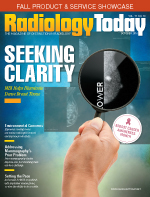 October 2016
October 2016
Editor's Note: Increase Your Awareness
By Dave Yeager
Radiology Today
Vol. 17 No. 10 P. 3
It's Breast Cancer Awareness Month so let's take a moment to reflect on the toll that the second leading cancer killer among women takes: According to the American Cancer Society, approximately 1 in 8 women—12% of women in the United States—will develop invasive breast cancer in her lifetime. This year, about 246,660 new cases of invasive breast cancer will be diagnosed—along with 61,000 cases of carcinoma in situ, the noninvasive and earliest form of the disease—and around 40,450 women will die from breast cancer. All told, American women have a 1 in 36 chance of dying from breast cancer.
There is some good news in the numbers, however: The breast cancer death rate has been declining since 1989. Improvements in screening, detection, and treatment seem to have made a significant dent in breast cancer's spread, although, as we reported in July, there are some disagreements about who should be screened and how often. In any case, finding breast cancer before it has a chance to spread seems like a reasonable strategy for preserving patients' quality of life and saving lives overall.
This month's issue has a couple of articles that look at detection and screening. Kathy Hardy's feature on molecular breast imaging looks at the results of a large retrospective study that found promising results for the use of MBI, both as an adjunct and a primary screening modality.
And Juliann Schaeffer speaks to several breast imaging providers about the challenges and benefits of obtaining prior mammography images for breast screening; although priors have long been recognized as being valuable to the process, getting them in a timely manner is not always easy. With the Cancer Moonshot initiative underway, perhaps patient records will become more accessible and newer screening modalities will become more widely available in the months and years ahead.
Also in this issue, Jeannette Sabatini takes a look at ergonomics for radiologists, a growing concern due to the ever-accumulating volume of imaging studies, and Beth W. Orenstein reports on the increasing need for MR-safe pacemakers.
Enjoy the issue.
david.yeager@gvpub.com

